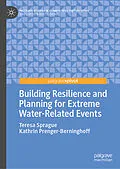This book discusses what it means for cities to work toward and achieve resilience in the face of climate change. The content takes an urban planning perspective with a water-related focus, exploring the continued global and local efforts in improving disaster risk management within the water sphere. Chapters examine four cities in the US and Germany - San Francisco, San Diego, Solingen and Wuppertal - as the core case studies of the discussion. The chapters for each case delve into the current status of the cities and issues resilience must overcome, and then explore solutions and key takeaways learned from the implementation of various resilience approaches. The book concludes with a summary of cross-cutting themes, best-practice examples and a reflection on the relevance of the approaches to cases in the wider developing world.
This book engages both practitioners and scientific audiences alike, particularly those interested in issues addressed by the Sendai Framework for Disaster Risk Reduction 2015-2030, the 2030 Agenda for Sustainable Development, the recent Water Action Decade 2018-2028 and the Rockefeller Foundation's 100 Resilient Cities.
Autorentext
Teresa Sprague is a water resources planner at Woodard & Curran Inc. in San Francisco, California. After her M.Sc. at the University of Oxford, UK she was awarded a Marie Skodowska-Curie Actions Research Fellowship from the European Union and completed her PhD in water risk governance at the Technical University of Dortmund, Germany.
Kathrin Prenger-Berninghoff is a lecturer and scientific staff of Urban and Regional Planning at RWTH Aachen University, Germany. She is a recipient of a Marie Skodowska-Curie Actions Research Fellowship from the European Union and completed her PhD in spatial planning at the Technical University of Dortmund, Germany.
Inhalt
Introduction (5 pages max)
State of science in climate resiliency and current efforts
This chapter introduces the state of science for this within cities and urban development, addressing:
•What do we mean by resilience? (how we apply this in a practical sense so implementation within an urban setting what does it mean within this setting)
•What is meant by being climate resilient?
•Also briefly address what is meant by social readiness (awareness and willingness to engage), and who plays the main roles
The global dialogue and examples in practice
•Should present the state of global dialogue and connect to other major global policy including SDGs and post Sendai Framework Examples of current efforts (global scale with brief mention of some specific examples)
•Provide examples from e.g. the 100 Resilient cities campaign and the work of the Rockefeller Foundation and UNISDR (also current developments within the water sector side of this)
Chapter setup
•The chapters presented in this eBook provide a series of practical cases from Germany and the US
•The structure of these chapters is as follows:
oBrief introduction to case
oCurrent issues faced by planning and current natural and human environmental issues
oSolutions pursued (practical solutions focus)
oLearning points box (basic take home points for educational focus)
Our key terms
[currently will use from combination of UNISDR terminology and stakeholder analysis research, to be updated later]
•Resilience: (to be added shortly)
•Climate resilient: (to be added shortly)
•Public actors: (to be added shortly)
•Private actors: (to be added shortly)
•Stakeholders: (to be added shortly)
Sample Case Chapter Structure (12 pages max)
[this section to be removed in final version and for now serves as a chapter guidance]
Brief introduction to case
•This brief section provides an idea for the reader of location, demographics, land use distribution, natural and human-based resources
•It should also be stated whether the case is connected to global efforts including e.g. funding from the EU, from the Rockefeller Foundation or falls within the 100 Resilient Cities and UNISDR efforts, etc.
Current issues faced by planning and current natural and human environmental issues
•It would be great to have this include an extreme events focus: what kind of events does the case face? What have been its historic events? (e.g. what kind of damage, how long did it take for recovery and who were the major actors in rebuilding)
•The content of this section should address what are the desired outcomes for the future development of the city? Who is interested in achieving these outcomes? (the population, the government, private sector as well?) This should help transition to the next section on what solutions were pursued
•This should include a description of the kind of solutions that have been pursued in the case to make the city more (or at least work toward) resilient
•What kind of best practices were employed? (and how they directly addressed the city's challenges in trying to enhance resilience)
•Consider also the main components of the call as follows:
oHow solutions address what is desirable and undesirable in building climate resilient societies?
oIn the solution: What does a resilient society look like?
oWhere slow transitions needed or rather rapid transformations?
oWere there any implications within the case solution of how governments can create coherent, forward-looking and flexible policy?
oParticularly, how and does the solution help the society:
Support ecosystem conservation
Promote sustainable use of natural resources
Encourage sustai...
Titel
Building Resilience and Planning for Extreme Water-Related Events
EAN
9783319997445
Format
E-Book (pdf)
Hersteller
Veröffentlichung
11.10.2018
Digitaler Kopierschutz
Wasserzeichen
Dateigrösse
5.47 MB
Anzahl Seiten
183
Unerwartete Verzögerung
Ups, ein Fehler ist aufgetreten. Bitte versuchen Sie es später noch einmal.
